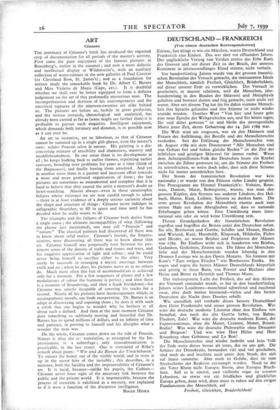ART
Cezanne
THE centenary of Ckzanne's birth has produced the expected crop of documentation for all periods of the master's activity. First came the pure enjoyment of the famous pictures at Rosenberg's, earlier in the summer ; and now a more didactic and intellectual display at Wildenstein's, with an auxiliary collection of water-colours in the new galleries of Paul Cassirer
Cleveland Row, St. James's) ; and as a foundation for serious study the remarkable book by Dr. Albert C. Barnes and Miss Violette de Mazia (Cape, 2rs.). It is doubtful whether we shall ever be better equipped to form a definite judgement on the art of this profoundly mysterious man. The incomprehension and derision of his contemporaries and the uncritical raptures of the nineteen-twenties are alike behind us. The pictures are before us, luckily in great profusion, and the serious research, chronological and analytical, has already been carried as far as (some might say farther than) it is profitable to pursue such enquiries. Intelligent enjoyment, which demands both intimacy and distance, is as possible now as it can ever be.
An art so inventive, yet so laborious, as that of Cezanne cannot be summed up in a single glib phrase, even the master's own : ref aire Poussin selon la nature. His painting is a dis- concerting mixture of sensibility and clumsiness, mastery and muddleheadedness. In one sense there is no development at all ; he keeps harking back to earlier themes, repainting earlier canvases, brooding over problems for years at a time (think of the Baigneuses), and finally leaving them unsolved. And yet in another sense there is a patient and incessant effort towards a more and more profound organisation of form ; the last pictures are sometimes so monumental and complete that it is hard to believe that they caused the artist a moment's doubt or heart-searching. Almost always—even in those catastrophic failures whose existence we are now candid enough to admit —there is at least evidence of a deeply serious curiosity about the shape and structure of things : Cezanne never indulges in calligraphic flourishes, to fill in space and time until he has decided what he really wants to do.
The triumphs and the failures of Cezanne both derive from a single cause ; the ultimate incompatibility of what (following the phrase just mentioned), one may call " Poussin " and " nature." The classical painters had discovered all there was to know about solid matter. Cezanne's friends, the Impres- sionists, were discovering all there was to know about thin air. Cezanne himself was perpetually torn between his pas- sionate sense of the density of rocks and stones and trees, and his exquisite appreciation of light and colour ; and he could never bring himself to sacrifice either to the other. Very rarely he succeeds in arranging a mystic marriage between earth and air ; when he does, his pictures move us as no others do. Much more often this feat of accommodation is achieved only for a moment. For a few sequences of planes and a few modulations of colour the harmony is perfect ; and then there is a moment of floundering, and then a frank breakdown—for Cezanne was utterly incapable of covering his tracks for a second. Nearly all his pictures have inconsequences which, in unsympathetic moods, one finds exasperating. Dr. Barnes is an adept at discovering and exposing them ; he does it with such a relish that one begins to wonder why he bothers at all about such a dullard. And then at the next moment Cezanne does something so sublimely moving and beautiful that Dr. Barnes has to spend millions of dollars, and an infinity of time and patience, in proving to himself and his disciples what a wonder the man was.
On the whole, Cizanne comes down on the side of Poussin. Nature is what she is : translation, as attempted by the Im- pressionists, is a subterfuge ; only transubstantiation is practicable, in the last resort. One is reminded of Rilke's remark about poets : " Wir rind die Bienen des Unsichtbaren." To extract the honey out of the visible world, and to store it up in the secret hive of the invisible ; this describes, in a measure, both the lucidity and the impenetrability of Cezanne's art. It is lucid, because—unlike his pupils, the Cubists- Cezanne never loses sight of the necessary link between the public and the private world. It is impenetrable, because the process of secretion is exhibited as a mystery, not explained as if it were a function of the discursive intelligence.
ROGER HINRS.










































 Previous page
Previous page